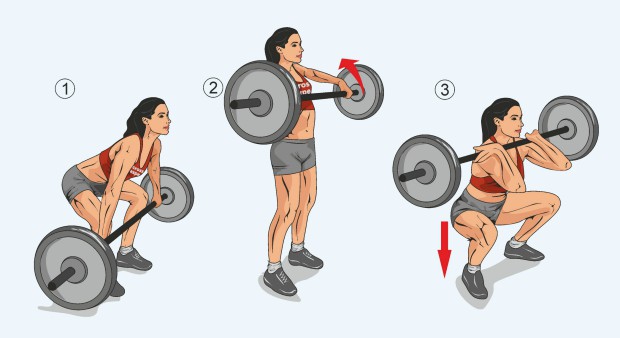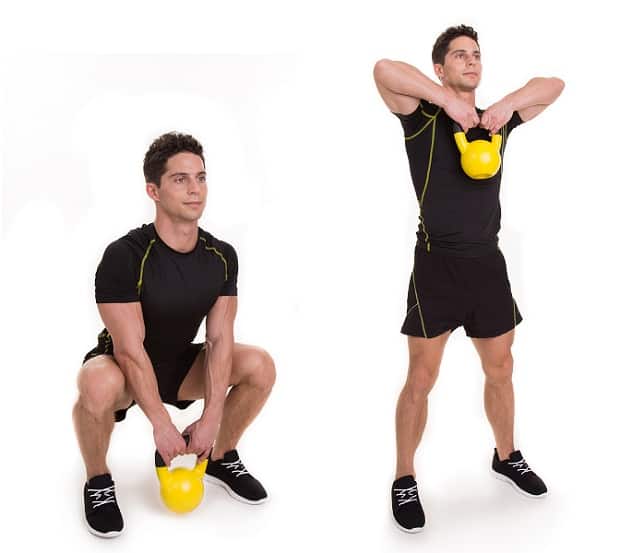
The sumo kettlebell pull to the chin is an exercise with which you can diversify your CrossFit workouts. Basically, this exercise is a derivative of the sumo-style deadlift and the narrow grip broach.
In terms of biomechanics, such a pull is most reminiscent of taking a barbell to the chest (as well as kettlebells or dumbbells) in any way – the principle of operation is almost the same.
The benefits of exercise
With this exercise, you can perfectly develop the strength endurance of the muscles of the legs and shoulder girdle. To do this, you need to work for a large number of repetitions with light weight. Then the progress in thrusters, barbells to the chest, shvungs and barbell pulls to the chin will be much stronger.
Moreover, this exercise is very suitable for working against the clock. For example, set a goal to complete 50 sumo kettlebell rows to the chin in one minute. First, you master it 20 times, then 30, 40 and so on. This will allow your muscles to adapt to faster work, and your records in many CrossFit complexes will improve. The fact is that you will tune the psyche so that the brain gives a signal to the muscles to work in a mode of short rest time between contractions. It increases aerobic and anaerobic endurance. In addition, you spend a lot more energy and burn fat more, since glycogen stores are depleted quite quickly during this training.
What muscles work?
The movement can be roughly divided into two phases: a sumo deadlift and a narrow grip pull to the chin.
With the deadlift, the main work falls on:
- adductor muscles of the thigh;
- gluteal muscles;
- quadriceps.
The biceps of the hip and the extensors of the spine work a little less.
When the knees are fully extended, we begin to pull the kettlebell towards the chin. The main working muscle groups in this case are the deltoid muscles (especially the anterior bundle) and the trapezium. A small portion of the load also falls on the biceps and forearms.
During the entire movement, the abdominal muscles act as stabilizers, due to which we maintain balance and do not allow the weight to fall down too sharply.

Exercise technique
The technique for performing the exercise looks like this:
- 1 Place the kettlebell on the floor in front of you. The bow of the weight should be parallel to the body. Place your feet a little wider. How wide depends on your stretch, you shouldn’t feel any discomfort in the inner thigh.
- 2 Keep your back as straight as possible, only a slight forward bend (literally 10-15 degrees) is allowed. Without bending down, sit down and grab the bow of the kettlebell with both hands. Use a closed grip.
- 3 Using your leg muscles, stand with the dumbbells. Keep your back straight throughout the entire lift. The movement should be as explosive and fast as possible in order to give the weight good momentum. Then the shoulders will not fatigue as quickly and you will be able to do more reps. The same principle of operation is applied when swinging the kettlebell with both hands in front of you.
- 4 When you have fully straightened and straightened your knees, the weight should “fly up” a little more by inertia. This is what you need to take advantage of. You do not need to pull her to the chest, you just need to continue her movement. Slightly straining your shoulders and bending your elbows, pull the kettlebell up to about chest level. The movement is performed in much the same way as the barbell pull to the chin with a narrow grip. To emphasize the load on the shoulders, rather than on the trapezium, when lifting, spread your elbows to the sides. At the top, the elbow should be above the hand.
- 5 After that, do the next repetition. If you are working in a crossfit complex, where you need to perform as many repetitions as possible for a while, you need to put the kettlebell down as sharply as possible, tilting your back down. If not, do the same, only in reverse order.

